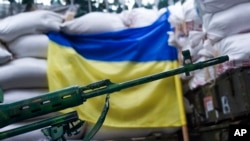The head of the independent body monitoring the cease-fire in eastern Ukraine has told VOA the conflict is on the brink of a major escalation.
Monitors from the Organization for Security and Cooperation in Europe report up to 7,000 cease-fire violations every week along eastern Ukraine's 500-kilometer front line. Principal Deputy Chief Monitor Alexander Hug said that's just the beginning.
"Indeed, the last three weeks were some of the most violent we have registered ever, with not only small arms being used in those very close proximity positions, but also heavy weapons that not only should not be used, but should not be there where they are currently positioned," he said.
Heavy weapons were meant to be withdrawn under the 2015 Minsk cease-fire agreement, but OSCE monitors report that weapons including Grad multiple rocket launchers are being used in civilian areas.
"We still see weapons in the areas where they should not be, but we cannot verify them any longer as we have no direct access to them," Hug said. "Often we only hear them and do not see them. The fact is that both sides have not done what they promised to do."
Civilians pay the price for the lack of security. Families have been separated and communities divided. In hot spots like Donetsk and Horlivka, the humanitarian situation is worsening as winter sets in.
"Those living in the security zone, which is supposed to be a zone without danger, with no risks, they live now in an area that is arguably the most risky and dangerous area in all of Ukraine," Hug said. "And there the civilians suffer from the absence of proper utility services, no electricity, gas or water."
OSCE monitors have come under attack several times. Hug said it is vital that both sides respect the Minsk deal and allow its monitors to verify the pullback of weapons, before a surge in violence triggers a wider conflict.









